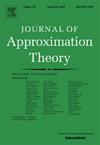The Pearcey integral in the highly oscillatory region II
IF 0.6
3区 数学
Q2 MATHEMATICS
引用次数: 0
Abstract
We consider the Pearcey integral for large values of and bounded values of . The standard saddle point analysis is difficult to apply because the Pearcey integral is highly oscillating in this region. To overcome this problem we use the modified saddle point method introduced in López et al. (2009). A complete asymptotic analysis is possible with this method, and we derive a complete asymptotic expansion of for large , accompanied by the exact location of the Stokes lines. There are two Stokes lines that divide the complex plane in two different sectors in which behaves differently when is large. The asymptotic approximation is the sum of two asymptotic series whose terms are elementary functions of and . Both of them are of Poincaré type; one of them is given in terms of inverse powers of ; the other one in terms of inverse powers of , and it is multiplied by an exponential factor that behaves differently in the two mentioned sectors. Some numerical experiments illustrate the accuracy of the approximation.
高振荡区域的皮尔斯积分2
我们考虑的是 Pearcey 积分 P(x,y),适用于 |x| 的大值和 |y| 的有界值。标准的鞍点分析难以应用,因为皮尔斯积分在这一区域高度振荡。为了克服这个问题,我们采用了 López 等人(2009 年)提出的修正鞍点方法。我们得出了 P(x,y) 在大|x|时的完整渐近展开,并给出了斯托克斯线的精确位置。有两条斯托克斯线将复 x 平面划分为两个不同的扇形区域,当 |x| 较大时,P(x,y) 在这两个扇形区域的表现不同。近似值是两个近似级数之和,其项是 x 和 y 的初等函数。这两个近似级数都是 Poincaré 类型;其中一个用 x 的反幂表示,另一个用 x1/2 的反幂表示,并乘以一个指数因子,在上述两个扇形中表现不同。一些数值实验说明了近似值的准确性。
本文章由计算机程序翻译,如有差异,请以英文原文为准。
求助全文
约1分钟内获得全文
求助全文
来源期刊
CiteScore
1.90
自引率
11.10%
发文量
55
审稿时长
6-12 weeks
期刊介绍:
The Journal of Approximation Theory is devoted to advances in pure and applied approximation theory and related areas. These areas include, among others:
• Classical approximation
• Abstract approximation
• Constructive approximation
• Degree of approximation
• Fourier expansions
• Interpolation of operators
• General orthogonal systems
• Interpolation and quadratures
• Multivariate approximation
• Orthogonal polynomials
• Padé approximation
• Rational approximation
• Spline functions of one and several variables
• Approximation by radial basis functions in Euclidean spaces, on spheres, and on more general manifolds
• Special functions with strong connections to classical harmonic analysis, orthogonal polynomial, and approximation theory (as opposed to combinatorics, number theory, representation theory, generating functions, formal theory, and so forth)
• Approximation theoretic aspects of real or complex function theory, function theory, difference or differential equations, function spaces, or harmonic analysis
• Wavelet Theory and its applications in signal and image processing, and in differential equations with special emphasis on connections between wavelet theory and elements of approximation theory (such as approximation orders, Besov and Sobolev spaces, and so forth)
• Gabor (Weyl-Heisenberg) expansions and sampling theory.

 求助内容:
求助内容: 应助结果提醒方式:
应助结果提醒方式:


